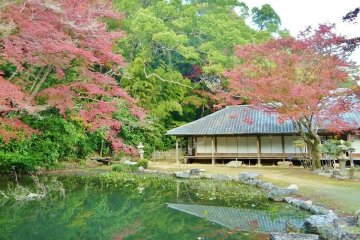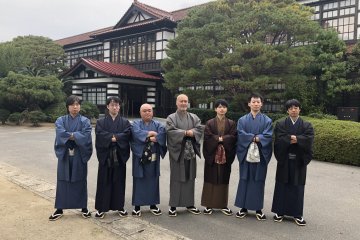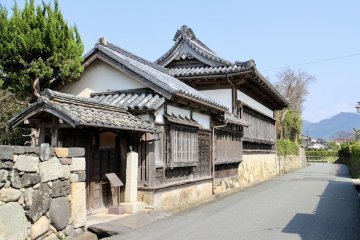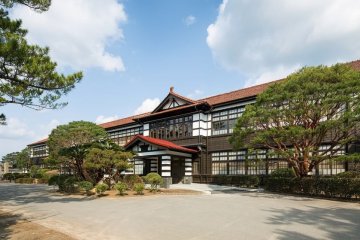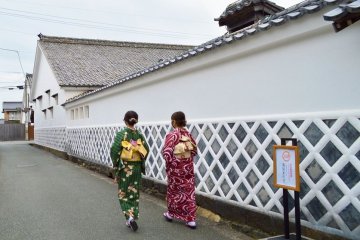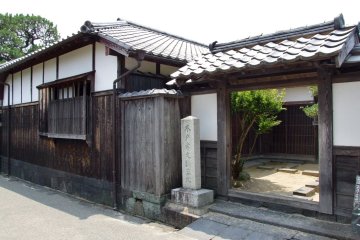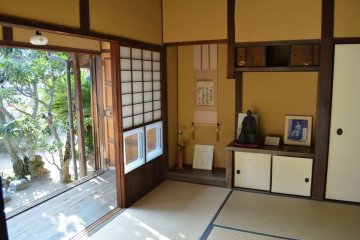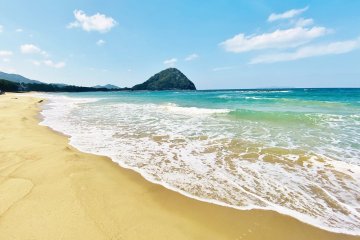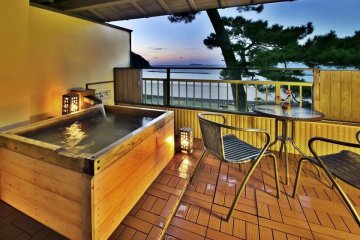Hagi City, located in Yamaguchi Prefecture, is a coastal area where time stands still.
This naturally-fortified region—encircled by the Hashimoto River, Matsumoto River, Sea of Japan, and mountains beyond—flourished as a castle town from the 17th to 19th century. Largely unscathed by natural disasters and war, Hagi’s castle town still stands today and acts as an enchanting gateway into another era.
Many of Hagi’s historical sights are situated in the city’s center and are within walking distance from each other. Here, you can explore quaint architecture, UNESCO World Heritage Sites, traditional art, preserved residences, and more.
Read on to learn more about Hagi’s historical highlights!
Hagi Meirin Gakusha

Hagi Meirin Gakusha is a local museum and tourist facility located in Meirin Elementary School’s former building, which is Japan’s largest wooden schoolhouse. Also, the building itself is situated on the original site of the Domain School Meirinkan, which feudal lord (daimyo) Yoshimoto Mori established to educate the Mori clan’s children.

The Main Building is free to enter and is home to a tourist information area, cafe-restaurant “Hagi Goyomi,” exhibitions about the ground’s history, a restored elementary school classroom, a souvenir shop, and much more. From here, you can visit Hagi Meirin Gakusha (Building No. 2) for a small admission fee. The historical school houses the World Heritage Visitor Center, which introduces Japan’s Industrial Revolution heritage, and the Bakumatsu Museum, which displays a variety of artifacts from the Meiji Restoration (a political event in which Japan’s feudal system ended and the emperor rose to power). The area around the school is also worth exploring as it is home to City Designated Tangible Cultural Properties and Nationally Designated Historical Sites—one of which is the commanding Yubikan, a long building that was once used for martial arts training and sword and spear matches.
Overall, Hagi Meirin Gakusha, from its historically significant grounds to its informative exhibits, is an excellent starting point for your exploration of Hagi City.
Hagi Uragami Museum

Established in 1996, the Hagi Uragami Museum is an art museum that preserves and exhibits a core group of oriental arts from the world’s most valuable collections—donated by Hagi-born entrepreneur, Toshiro Uragami (1926-2020). Uragami’s vast collection features over 5,500 ukiyo-e artworks (Japanese woodblock prints) and about 600 oriental ceramics. Aside from Uragami’s donations, the museum also has a collection of 800 modern and contemporary ceramic and craft works. In 2010, the facility added a Pottery Annex that displays Hagi-yaki, or Hagi ware, made by modern and contemporary artists. Hagi ware is a highly regarded form of traditional pottery in Japan with over 400 years of history.
The sleek facility was designed by Kenzo Tange, who was a world-famous Japanese architect known for designing the Hiroshima Peace Memorial Park, among other notable structures. In addition to its regular exhibits, which it rotates throughout the year, the museum also hosts special exhibitions. Be sure to review the museum’s exhibits and events schedule (Japanese only) prior to your visit.
Merchant District (a Part of Hagi Castle Town)

During Japan’s centuries of peace under the Tokugawa shogunate, Hagi’s merchants thrived, and this wealth is best represented in Hagi’s preserved Merchant District. This historical area is a part of the UNESCO World Heritage “Sites of Japan's Meiji Industrial Revolution” and is characterized by its white-walled streets, wooden merchant houses, and summer orange (natsumikan) trees. In fact, the combination of these lush trees against the streets’ white walls is a treasured visual of Hagi.
The district’s aforementioned wealth is most visible in its white-plastered and black-tiled earthen walls, which have crisscross patterns. These walls are called namako-kabe, or sea-cucumber walls, and symbolize the area’s prosperity. Of course, the buildings themselves are also aesthetic masterpieces and exemplify Edo Period architecture. Interestingly, many of the district’s streets are named after affluent merchants, and some of their well-maintained residences are open to the public.
Aside from its historical intrigue, the area is also home to shops and cafes that are perfect for recharging during your sightseeing adventures.
Kikuya Family Residence

Kikuya Family Residence is located in Hagi Castle Town’s Merchant District and is the former home of the prosperous merchant family, Kikuya, who closely served the ruling Mori Clan by governing the town and offering their home as a guest house for distinguished visitors. The lavish home was built in the early 17th century and is one of the oldest and best maintained examples of Edo Period merchant architecture in Japan. Five of the residence’s buildings—the main warehouse, the principal warehouse, the treasury, the rice warehouse, and the traditional kitchen area—are listed on the National Register of Important Cultural Properties.

In addition to its spectacular architecture, the facility also has a Japanese garden, displays historical artifacts, and offers a kimono-matcha and a tea ceremony experience.
Kikuya Yokocho

As you have likely surmised, Kikuya Yokocho is the street where the Kikuya Family Residence is located. This alleyway is arguably one of Hagi Castle Town’s most scenic areas and is popular for its brilliant white and black namako-kabe walls. In addition to Kikuya’s presence, the side street is also the birthplace of Shinsaku Takasugi, an Edo Period samurai who notably contributed to the Meiji Restoration. The home Takasugi was born in is partially open to the public and displays photos and artifacts related to the influential figure.
Given its pristine appearance and historical significance, Kikuya Yokocho was selected as one of Japan’s top 100 roads.
Former Residential District for Upper-Class Samurai (a Part of Hagi Castle Town)

Now that we have explored Hagi Castle Town’s Merchant District, let’s move on to its Residential District for Upper-Class Samurai. This strategically-located area was situated south of Hagi Castle and acted as the castle’s first line of defense. Today, the former samurai district is a part of the UNESCO World Heritage “Sites of Japan's Meiji Industrial Revolution” and is also recognized as a Nationally Important Preservation District for Groups of Traditional Buildings. The district is a cherished time capsule where well-maintained samurai residences and narrow wall-lined streets offer visitors authentic sceneries from Edo Period Japan. Thanks to the earthen walls that flank the alleyways, even the journeys between the samurai residences are captivating.
Former Residence of Kido Takayoshi

Kido Takayoshi was a major player in Japan’s modernization and is regarded as one of the “Three Heroes” of the Meiji Restoration. During his childhood, Takayoshi attended the Domain School Meirinkan where he learned about westernization. Once Japan’s feudal system fell, Takayoshi became one of the founders of the new government and joined other notable personnel in their exploration of American and European industries.

Today, Takayoshi’s childhood home, which is located on Edo-ya Yokocho, is open to the public and recognized as a Nationally Designated Historical Site. The residence serves as a beautiful example of Edo Period architecture from the late 19th century and features a tiled roof, two stories (which was rare during the Edo Period), and 12 rooms. The home displays artifacts from Takayoshi’s life, including photographs and his own childhood calligraphy.
Kikugahama Beach

While not noticeably related to history, Kikugahama Beach, located on Hagi City’s northern border, was once the site of an anticipated attack following the 1863 Battle of Shimonoseki Straits. Fortunately, this conflict never occurred. The beach is also in close proximity to Hagi Castle Ruins and offers mesmerizing vistas of the light-colored shore, crystal waters, and pine trees with Mt. Shizuki in the distance. Mt. Shizuki is the former site of Hagi Castle, and together, this view is one of Hagi’s most beloved landscapes.

Today, the beach is a popular summer time retreat for swimming, sunbathing, and water sports. The seaside spot is also famous for its sunsets. During this fleeting time, the soft gradients of the evening sun cast an ethereal glow on the landscape and highlight the darkened silhouette of Mt. Shizuki. If you are lucky, you may even be treated to skies colored with gradients of pink and orange.
Hagi Ichirin

After exploring Hagi City’s breadth of historical wonders, you may be looking for an accommodation to refresh and unwind. Let us introduce Hagi Ichirin. This luxurious hotel, located just off Kikugahama Beach, is home to outdoor and indoor hot spring baths, Japanese-Western fusion guestrooms, exquisite kaiseki (traditional Japanese multi-course dinners), and pampering services, such as massages and manicures. Also, since the hotel is only about a 10-minute walk from Hagi Castle Town, it is a great base for your exploration.
For elevated relaxation, book a room with a personal open-air bath that overlooks the ocean! Also, be sure to take advantage of the facility’s footbath as it offers expansive views of the encircling scenery. After your stay, you are guaranteed to leave feeling both mentally and physically renewed.
Hagi City: Where history perseveres
Hagi City is truly a hidden gem blessed with some of the country’s most well-preserved architecture and heritage from the Edo Period. If you are looking for a unique historical journey that deviates from typical tourist routes, consider visiting Hagi City during your trip to Japan!
Access to Hagi City
The most common ways to access Hagi City are via plane, Shinkansen, and express bus. The two closest airports to Hagi City are Yamaguchi Ube Airport and Hagi Iwami Airport. Flights to these airports depart from Tokyo Haneda Airport on a daily basis and take about 95 minutes. From the airports, Hagi City is 70 to 80 minutes away via a direct taxi service (reservations required) or rental car. There are also numerous bus options available.
For the Shinkansen, JR Shin-Yamaguchi Station is the closest Shinkansen station to Hagi City. Shin-Yamaguchi Station is on the main Sanyo Shinkansen line and is four hours and 30 minutes from Tokyo, two hours from Osaka, 32 minutes from Hiroshima, and 35 minutes from Fukuoka. Once you reach JR Shin-Yamaguchi Station, you can take a bus to Hagi City, which takes between 70 and 90 minutes.
Lastly, you can reach Hagi City via an express bus from Tokyo Station, Kyoto Station, Shin-Osaka Station, and Sannomiya Bus Terminal in Kobe. These journeys take about 14 hours and 30 minutes, 13 hours and 15 minutes, 12 hours and 20 minutes, and 10 hours and 45 minutes respectively.




